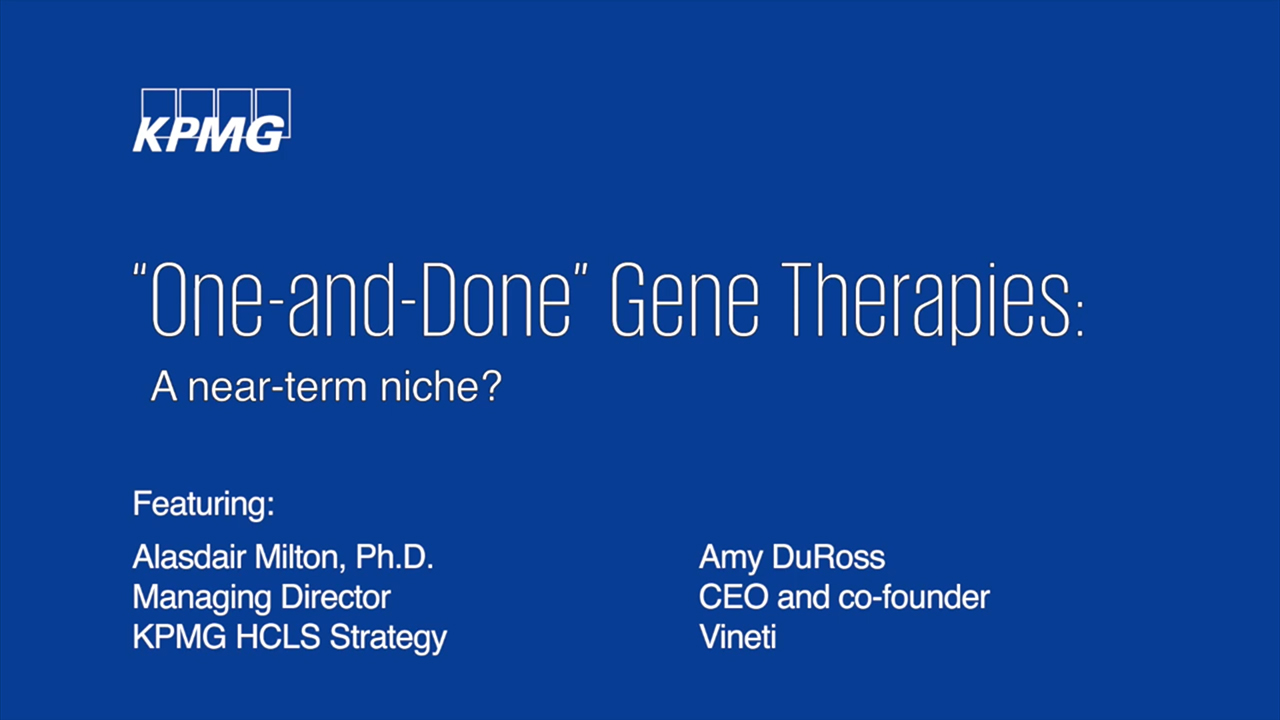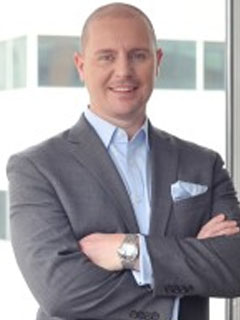Video transcript
Transcript Interview with Amy DuRoss, CEO and co-founder of Vineti
Alasdair Milton, PhD: Thanks for joining us today, everyone. It's my pleasure today to be speaking with Amy DuRoss, who is the co-founder and the CEO of Vineti. Amy, thanks again. I know you're really busy. Thanks so much for your time, and giving us your perspectives today on cell and gene therapy, and some of the challenges and the promise of cell and gene. Will be great to get your perspectives. I'm just wondering for the folks who are watching this interview. Can you give a little bit more background about yourself and about Vineti, as a company?
Amy DuRoss: I'd be delighted to. Alasdair, thank you so much for including myself and our company, Vineti, in this wonderful series that you're putting together. You're very busy too. Really appreciate the chance to chat today.
My name is Amy DuRoss. I'm the CEO and a co-founder of Vineti. My background is, first and foremost is a patient advocate. First, got my start very young, advocating for access to basic and translational trials research, support for funding at all levels of medical science. I was the co-author of the $3 billion Stem Cell Research Initiative, which created the California Institute for Regenerative Medicine, just reauthorized, in the end of last year for another $5.5 billion dollars support.
Also, I did a stint in precision medicine, worked at a genomics company, and then more recently in venture capital, where I focused uniquely on bioprocessing, personalized therapy, development as well as all the tools that we're focused on at Vineti. So that leads me to Vineti. Very quickly, Vineti is an enterprise platform, it's a solution that drives automated chain of identity and chain of custody for cell and gene therapies.
And really, if you think about any protocol, any workflow, any device, any therapeutic that has a requirement for a unique patient identifier, to ensure the right patient receives the right therapy at the right time, that's when you need a system to orchestrate your supply chain like Vineti.
Alasdair Milton, PhD: That's great. That's great context. And then, one of the issues that I highlight in the paper that I've written is around the manufacturing challenges that we see with cell and gene therapies, both in-vivo and ex-vivo, and the challenge there and scaling from small clinical trials up to the commercial space. What's some of your perspectives there? What are some of the challenges that you're seeing across that particular part of the cell and gene ecosystem, and how do we solve for those?
Amy DuRoss: Well, to be honest, because of the pace of medical discovery, the remarkable paradigm shift that the CRISPR technology and all of its iterations are forcing in our market, in the most positive sense of forcing, we're having a hard time as an ecosystem really digesting all of the technology at once. And I think this is again, back to when you have any unique, personalized protocol, where each product is a process, how do you scale that out?
What are the tools and how are you extrapolating out to think about more patients in a mass customization context? I think what we're seeing, obviously, there are some parts of the chain that have unique bottlenecks. LVVs and the like, for example, is how do we support the supply side that is again, commensurate with the demand.
We're seeing a lot of difficulty in this supply chain, just with frankly capacity overall for manufacturing, whether it's a CDMO context in source. I think everyone in this field is aware of the Holy Grail of closed loop manufacturing, which still alludes us. Although, there are some remarkable technologies coming online and a lot of investment focused in that direction.
I just think the other part, is the unique participation requirements of what used to be disparate parts, disparate stakeholders in the supply chain. For example, clinicians who are for the first time ever in autologous workflows, in some allogeneic workflows being asked to participate in driving the GMP process, right? That's historically never really been their role. It's never been their liability, for that matter.
Really creating an expectation across multiple different protocols. Back to this iteration, where we're seeing just incredible explosion of different NKs, PCVs, autologous, allogeneic, all sorts of remarkable therapies. All of them idiosyncratic, all of them having their own requirements.
And how do you begin to create an expectation among stakeholders like clinicians or everyone else involved in the chain, around how they can remain compliant, how they can participate, how they can also help streamline all in-service of extending access to more patients?
Alasdair Milton, PhD: One thing I want to touch on, I've talked to a couple of other interviewees around is the effect that COVID has had. What's your perspective? What effects have you seen from your advantage point on the effect that COVID's had on the cell and gene manufacturing and supply chain ecosystem? And then what do you think they'll look like coming out the other end of the pandemic?
Amy DuRoss: Such a great question. I'd say we're tracking now more or less around three-quarter delay. Fortunately, that hasn't extended further in terms of trial development and some commercial traction in our field, just because as everybody here likely knows, there's such a preponderance of the protocols in this market that rely on ICU access, at least as an initial requirement for administration.
So obviously, de-prioritization because of COVID patients really needing access to any ICU opportunity as there is out in the broader COE and community settings. I think, we're seeing that delay start to... As COVID begins to release its grip, God-willing, we're really seeing an uptick in vaccine distribution. I think, it's uneven across the different markets, even across the most progressed markets like the EU, which is a little bit behind the US at this point. Asia is pretty stable.
We're seeing a delay, but we're beginning to see some of the signs and signals that delays are diminishing and that we're going to begin to get back online. On the positive side, also, I would just say that because there was such a sort of remote management that was imposed broadly across pharma because of this pandemic, we have seen an interesting reliance, even in protocols, like the ones we support, which are heavy participation in clinic. Often, hospitalization is required as a part of administration.
We're seeing an adoption of more remote management tools wherever possible. And this is not really distinct from many other therapeutic areas in the market, where you're seeing an upswing in technological dependency, wherever we can insert monitoring opportunities or even frankly, on the manufacturing side, when you're actually able to do some... FDA has been able to do this quite remarkably well in the middle of this pandemic, remote inspections.
Is that true for every drug or every product that we're seeing? Absolutely not. Are we seeing the more progressive companies that have already installed some of these remote CRO management tools, for example, having an advantage in a marketplace with the externalities we are facing right now? Absolutely.
I'm very curious to see it again, as we continue to invest in shop floor technology, as we tighten all the integrations across this most complex supply chain in the history of medicine. I'm interested to see where technology can begin to drive even more efficiency. I think the pandemics had a real wedge of consciousness effect overall on the market. I think we're going to; we should expect to see a lot more reliance on technology overall, even in a market that's highly personalized, highly specific and does require some clinical interface today.
Alasdair Milton, PhD: COVID is almost been a catalyst in some way. I've heard it from a few different stakeholders. We talked about digital and remote monitoring the FDA has been doing, but what are some of the other innovations that you're seeing in cell and gene therapy from a manufacturing, supply chain in terms of shortening supply lines, innovative technologies that can help us really scale up faster? What are you seeing from your perspective?
Amy DuRoss: This is close to home, Alasdair, because we've invested so heavily in a build for purpose platform solution. If you think about Vineti, just as one example, across the supply chain, there are so many examples I could point out, but since Vineti is the one I live and breathe every day, it really is... How do you achieve a level of configurability and flexibility that is built for purpose, where you're really critical path in a supply chain that if it fails at any point in the process steps, probably introduces an adverse event, right?
It's not just the quality control. It's the fact that most of these patients are exceedingly ill and usually have one opportunity to be administered. The point is, having a level of flexibility and control, every part of the chain is super important. And, pharma in general is starting to embrace this platform approach because they have historically been more reliant on customized, vertically integrated, customized approaches to solving very hard problems, because in a customized environment with customized software, for example, you could put a set of requirements in place and you can nail landing. The problem in the market like ours, it's always evolving, and where essentially each protocol is to some degree personalized and the workflow requirements are changing.
You just can't... There's no fixed solution. I think that sort of mindset of, we're going to have to constantly adjust, we're going to have to support different workflows, we're going to have to amend regulations, are going to change. Products are going to change, even once they're approved. So we need to build from the beginning. We need to build with a level of flexibility and control inherent to our overall system.
And since Vineti is smart plumbing that connects so many disparate parts of the supply chain, that flexibility's even disproportionately more important because we're essentially connecting so many dots. I think that a lot has been written recently around CDMOs and back to vertical integration, but how do you access economies of scale in a more holistic approach to manufacturing, not simply just shop floor technology. And you see companies like Reliance or ElevateBio, others that we know are coming out, maybe haven't been public yet, but heavy investment in this area. Just as an acknowledgement, I think this has also been forced in part by the pandemic, sort of deficiencies of the supply chain around testing and vaccination. But, there's a lot of focus on shop floor technology, meeting other pieces of the chain and finding these economies of scale, even to the point of really combining funding and doing funding in connection with actual manufacturing, which is just a very interesting, and I think a far more efficient use of capital, if you can leverage economies of scale.
We're seeing just a fascination conviction with this market and a sense of okay, so we've got this medical science and we must convert it. We have to adjust reimbursement. We have to figure out how all these pieces are going to be consumable as a healthcare system. But none of it is, if we can't figure out the manufacturing. I think there's a lot of innovation on the capital being pumped into the picks and axes in this market right now as a result.
Alasdair Milton, PhD: It's a very innovative area. I think I've said this in every interview that I've had, it's probably one of the most innovative times in the bio-pharmaceutical, biomedical environments for the last 20 years, but it's very fragmented.
There's a lot of different companies that play big pharma, very small biotech, CDMOs, multiple stakeholders, very fragmented, there's a lack of coordination though. Vineti had a press release, I think at the end of March this year, where you announced a new coalition to try and coalesce around a standardization around the chain of custody ID. Can you just tell us a little bit more about that and why you think that's so important?
Amy DuRoss: Sure. The chain of custody ID is the unique patient identifier that is assigned when production and delivery begin in cell and gene therapy. And this is so important because, if you were to get therapy or vice versa, it would be a probably deadly event, right? The risks are great. The stakes are high. How do you assign a unique identifier per product or per process? The issue with patient IDs or chain of identity IDs is that if you've seen one, this is sort of the joke in the industry. Although it's very funny one because there is no guidance. There is no oversight on how to configure that unique patient identifier and to add to the complexity, these largely centers of excellence who are administering these therapies today, sometimes some of them have additional requirements on top of whatever the therapeutic manufacturer is putting forth as unique patient identity or identifier.
And that is a real problem, that's compounding. The more investment we have, the more clinical trials that are launched, and then, ultimately, the more commercial products you have. All this again, is even made further complex by the sort of mosaic of different requirements around PHI, for example, in the EU, what's going on in the interface with GDPR. While it might seem like a sort of mundane topic, especially related to the science or in a distinction to the science itself, which is just truly flabbergasting, it's absolutely crucial to the performance of the supply chain on behalf of patients and to scaling out these technologies. We were founded essentially as an independent company by the Mayo clinic and General Electric, really for two reasons, one - to attract the kind of extraordinary talent. We've been lucky to incentivize as owners here in the company who, range from enterprise software, to logistics, to QA, QC, to all the cell and gene therapy manufacturing acumen, and experience. And the second, half of the value proposition really was to promulgate and enable standards. And that it was an acknowledgement that a company like General Electric had from the beginning, because they have industrialized so many sectors over the history of their 150 year company. I would say that, first, we've seen one setback in gene therapy, were unfortunately an adverse event really cast a pull across the whole marketplace.
Let's learn from the past, but also understanding that it was more than chain/sharing of identity that we were going to have to streamline, simplify, standardize, if we were ever going to achieve this ultimate goal of creating a new market.
And that market means patient access, right? For cell and gene therapy to become a standard of care, we have to industrialize. To industrialize, we have to standardize. So we've done a lot of thinking about this, working on soliciting lots of feedback from the marketplace. Our partners have asked us to go public and create even more sunshine.
We presented the ID to the standards coordinating body, talked to ISCT, talked to some international groups about it, all soliciting feedback with the perspective, this is a recommendation it's open source, there's requirement to use Vineti software to access this standard. It's really put forward along with our biopharma partners is that, let's get started, let's begin to find some commonality across particularly different markets. Since this manufacturing landscape is so distributed and you have lots of cross border shipments, let's just align and get started. We can always evolve a framework. Lord knows we can evolve the science. We can evolve a framework that is attached to it. But the idea was just to get some focus and attention because it is so fragmented. And I think that again, we have enough complexity to deal with the actual production and delivery. Let's find the places where we can agree and align and reduce complexity wherever possible.
Alasdair Milton, PhD: And then that's clearly coalescing around the movement of the patient sample. When you look at the raw material supply, though, it's also very fragmented. You have done a lot of work in this space and there's multiple vendors for the cytokines, the media, there's a lot that goes in, the plasmid. There's a lot that goes into making cell and gene therapy. I wonder, what role can Vineti or others play in helping to shorten supply chains, make things less complicated for CDMOs and pharma company in-house manufacturing?
Amy DuRoss: We've just begun to scratch the surface, Alasdair. Because we're hitting a level of critical mass, it's early critical mass in a truly statistical significance context, but to really leverage analytics. I think the supply side of this marketplace is such a ripe target for smart manufacturing, the sort of internet of things, to borrow the phraseology that was commonplace at General Electric, my alma mater. But I think that the companies like the Vineti just accrue data because we live in integration. If you think about systems that orchestrate supply chains, they are driven by integration to existing installed systems like ERP or CRM or the CTMS, wherever you are, again, in the R&D life cycle or commercial stage, there are going to be a different set of alphabet soup systems that are going to be supporting your manufacturing effort and distribution effort.
I think we're just seeing the beginning of that. Vineti will never be an ERP system. We don't need to be, there are ERP systems who have specialized. We specialized in chain of identity and chain of custody automation. And so we can, again, by proxy supercharge some of these existing installed systems, give them access to more data across... Sort of a spider effect across the broader chain, which ERP systems or manufacturing facilities have disproportionate dependency upon than in any other biologics or any other therapeutics contexts that's come before. We do see why we will get control the inventory management, that's not part of our core competency. We can inform that for sure. And we can look across the chain to see where failure events happen, where there have been more efficiencies to replicate those sequence of events and those inputs again, from the inventory management side, I think it's just the beginning.
It's where all the value around truly making a market happens. Because you have to have those kinds of smart insights if you're going to ultimately just manage capacity. And that's the big issue with mass customization is how do you put this level of capacity management into the most efficient frame for success as possible? Because you're trying to do something so complicated for one patient at a time. So it's all analytics, that's where it's driving. And we just so excited because we've been in this business now for about five years and we've been watching this sort of steadily increasing number of patients go through our platform and we have obviously monitored the market extremely tightly. So we're just getting to the point where you can say, okay, de-identify all of these samples across a network and look at everything. Not just throughput, but how you characterizing those cells, what's going into them on an inventory management side, these are all just insights that we're on the verge of being able to capture and put to work, which is super exciting.
Alasdair Milton, PhD: And finally, we've talked about how innovative this space is. It feels like every day, there's a new startup. I see them inside their spinoffs that's trying to optimize AAV capsids, or I think I've seen some in vivo CAR-Ts, I've seen startups around bringing tools that can really simplify the manufacturing process and cell and gene. So a thriving area. What are you most excited about for the space and the next three to five years, I guess, where do you see maybe some of the challenges still remaining and how do we solve for those?
Amy DuRoss: Such a great question. So for someone who's, dating myself a little bit, I've been in this market for well longer than I... Yeah, because I really did get started in personalized medicine when I first testified before Congress for supportive basic research. But I think it's unbelievable what's happening. It's excess of Moore's law rate of discovery and exponential expansion here. I think CDT/CGT3.O is all about CRISPR, even more new therapeutic challenges in technologies. We're not just one-and-done. With a very complex set of organisms that are human beings, we're going to continuously refine our knowledge back to analytics so that we're even more and more precise as we move forward. And that may not be a single curative administration of a CAR-T. It may actually be multiple PCV, personalized cancer vaccine.
It could be, as you said, originate in utero. We've seen workflows that originate in utero, have tissue samples in utero, genomic sequencing in utero with predisposition analysis that is then slated for another blood draw every three years until pre-symptomatic levels are achieved without saying more. I don't want to betray confidentiality, but just those sorts of remarkable sort of, when you think about true personalization and intervention ahead of chronic disease, we're 10, 15 years from not being a true standard of care, in my opinion, because the, so what precision medicine, meaning you understand that organism, we understand the genome increasingly we're getting more application of that genomic discovery. And then that meets this remarkable application, the CRISPR, just being an absolute sort of force multiplier of that connection between knowing and acting on an individual organism.
I can't overstate my excitement. I do think... and again, as someone who's been working in this field a long time, it's like a hallelujah set of moments here. But I also think that the opportunity I mentioned earlier about insertion of digital tools, we're going to see this whole sort of telemedicine. I think it's continue to be on the upswing, despite some enormous sort of movements and disruptions in the market already. But I think that will introduce more efficiencies. There's now more of a consumerism or an expectation among patients wherever they are in their care pathway, that they're going to be met by technology, and that it's going to be increasingly personalized. And so that willingness to also be sharing of information, which we see in other environments outside of the U S have frankly leapfrogged some of our approaches to personal data?
I think there's going to be more interest in, hey, my data has value to me. It also has value to the broader population. So I think that CRISPR sort of that CGT3.O continuing to iterate the adoption of more digital technologies that can really not just promote intervention, but compliance among patients. That's a really interesting intersection that I think is going to drive more efficiency and therefore extend more access for high value therapies like the ones we're discussing today. I mean, I think some of the challenges are frankly, where you're seeing a lot of the investment dollars being driven right now, which is the picks and axes, right? There's a sense that, well, these aren't small molecules, we have to actually reinvent some portions. Maybe there are pieces, again, like some of the installed therapies we can apply.
We can apply what their core competency is into this new chain, but we're going to have to build for purpose. And some of these pieces, including like the deep tools that are actually engaged in more of a closed loop, manufacturing effort. Companies like Reliance who's raising enormous amounts of capital to do a number of these things at once, give me confidence, especially cause they're such an incredibly competent team at the helm in these places. But I think it's going to require all of us to respect core competencies because no one company, no matter if you have two or three or eight or 10 or $50 billion, no one company, no one group of people is going to solve all of it at once or maybe even ever. It's just so complex. The more we take the layers off of just chain of identity, which is our bread and butter, the more complexity we find.
If you look across the chain, there's so many competencies that have to come together coupled with capital and investment. I have confidence, but the only thing I would say I'm afraid of is overreaching, right? You really have to say, I think we went through the first four or five years of Vineti with a sense of the ecosystem. And you're like, how hard is this? Like, isn't the hard thing the science? Well, yes, the hard thing is the science, but then consuming the science maybe equally harder or maybe even more difficult, especially if you're going to achieve a standard of care. Some humility is coming in, which is very encouraging. I just really encourage all of my colleagues to think about where you can leverage core competencies because we're creating a new market that requires a largely new infrastructure, some kind of repurposed installed pieces, but a lot more built for purpose than I think we imagined coming into the market.
And so leverage as opposed to trying to vertically integrate and create all of your own value, leverage where you can because all of our biopharma partners that are going to continue to compete on efficacy, full stop. That's really where the competency comes and bringing these therapies to market effectively, whether in clinical or commercial phase, but protocol efficacy is everything. And then the rest of the chain has to really work on how to leverage, standardize wherever possible, even if it means giving something over to get something more. I think whenever there's a lot of capital suddenly invested in a marketplace, there's this like knee-jerk reaction to try to do it all yourself, could capture more value. I just really encourage people to steer away from that thinking. Leverage competency where you find it, as opposed to trying to do it yourself across this kind of a chain anyway.
Alasdair Milton, PhD: That's a great point. And then, it comes back to one of the points I make in the paper is, it's going to stay the course. So when you talk about biopharma companies and I know there's in the ecosystem is to actually stay the course in this area. Because an example I give is back in the 2010 to 2014 timeframe, when RNAi was a hot area, there was a couple of clinical setbacks and some big biopharma companies stepped out of that area. And it was only those smaller companies that kind of stay the course and then subsequently launched those therapies. That's the reason we have them. They were willing to invest and stay the course and overcome those delivery challenges. I think that's so important because ultimately, and I've had a couple of conversations with patient groups. CureDuchenne and Sick Cells is we're doing this for patients right. At the end of the day, that's why we're doing this.
Amy DuRoss: Absolutely. And the genie's out of the bottle, right? There is a real value in these medical technologies in curative value in many cases, curate of late stage disease. That is just fundamentally unprecedented, especially in some of the diseases we're serving today. My biggest fear, once you have this technology out of the box, if you will, we're seeing it so incredibly rapidly, it will exist. Now, we don't want it to be relegated to only the insured or only the pay for service type profile patients. And I do think that's a real concern. It's as concerning to me as this concern around patient safety, where standards really helped drive a sense of expectations of behavior in a supply chain. That is protective of patient safety. The other piece is access. And I think of that as a patient safety issue as well, issues should not be relegated to just the fortunate sort of insured and connected patients in this market. I think we found a new way to address chronic disease and we really need to figure it out at a scale.
Alasdair Milton, PhD: Absolutely. That's a great note to end on and I want to just thank you once again. It's been a fascinating conversation. Thanks once again for your time, Amy, it's been great.
Amy DuRoss: Thanks so much for your interest. Really appreciate it. You have a great day, Alasdair.
Alasdair Milton, PhD: You too, thanks Amy. Bye-bye.
Amy DuRoss: Bye.








